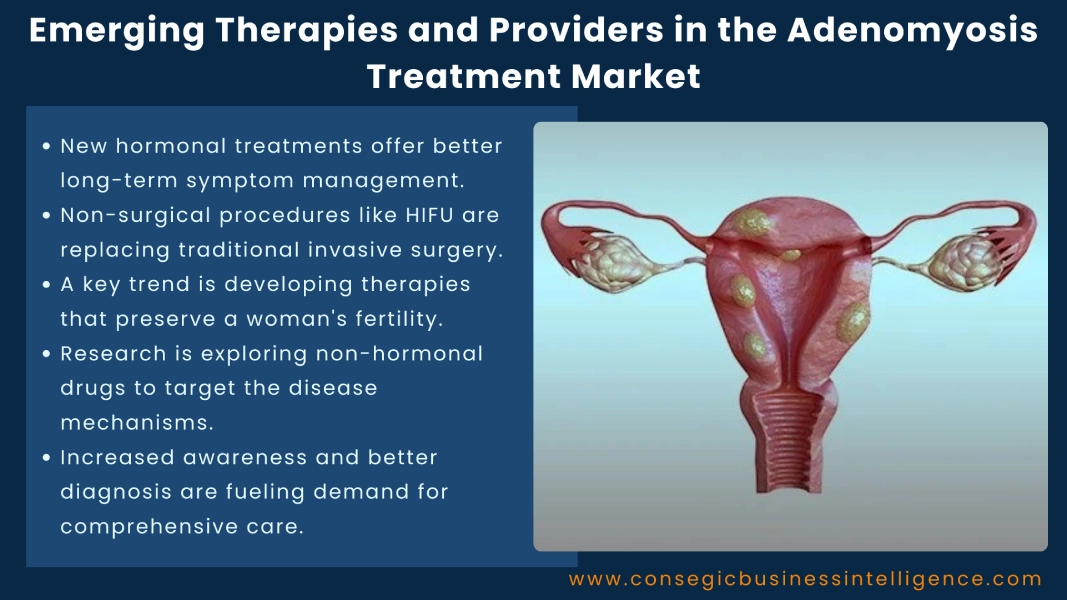Emerging Therapies and Providers in the Adenomyosis Treatment Market
Adenomyosis is a complex gynecological condition where endometrial tissue grows into the muscular wall of the uterus, leading to heavy menstrual bleeding, severe cramping, chronic pelvic pain, and fertility issues. Traditionally, treatment options were limited to hormone therapy, pain relief, or hysterectomy in severe cases. However, growing awareness, rising diagnostic rates, and advances in women’s health research have accelerated innovation in this space.

The adenomyosis treatment market is shifting toward more targeted, less invasive therapies that not only address symptoms but also improve quality of life and preserve fertility. Alongside these therapeutic advancements, global pharmaceutical companies, device innovators, and specialized medical centers are stepping forward to expand treatment access and improve outcomes for patients. In this blog, we will explore the emerging therapies showing strong promise and leading providers actively shaping the global adenomyosis treatment market.
Emerging Therapies in the Market:
- GnRH Receptor Antagonists (e.g. Relugolix + add-backs)
Oral GnRH receptor antagonists suppress ovarian hormone production, reducing uterine bleeding and pain. Combinations with low-dose estrogen/progestin (so-called “add-backs”) help manage side effects like bone density loss. Early clinical studies show meaningful reductions in menstrual blood loss and dysmenorrhea in adenomyosis patients.
- Selective Progesterone Receptor Modulators (SPRMs)
SPRMs modulate progesterone activity in uterine tissue, aiming to reduce adenomyotic lesion growth without the full suppression of ovarian function. They may offer better control of symptoms (bleeding and pain) while preserving fertility. Research is ongoing to confirm long-term safety and minimization of side effects.
- Hormonal IUDs / Levonorgestrel-Releasing Intrauterine Devices (LNG-IUDs)
LNG-IUDs are already widely used in clinical practice. They release progestin locally to thin the endometrial lining and reduce bleeding. Emerging work suggests newer versions with optimized dosing or combination with local therapies may improve outcomes for adenomyosis, especially in patients wishing to avoid hysterectomy.
- Uterine Artery Embolization (UAE) & High - Intensity Focused Ultrasound (HIFU)
For patients who want non-surgical options, UAE and HIFU are increasingly being explored. UAE reduces blood flow to adenomyosis lesions, causing them to shrink, while HIFU uses focused ultrasound to ablate (heat-destroy) affected tissue. Both offer alternatives to open surgery with lower recovery times.
- Novel Anti-inflammatory and Fibrosis-Targeted Agents
Recent research has identified that inflammation and fibrosis play key roles in adenomyosis pathology. Emerging experimental agents target inflammatory cytokines or fibrotic pathways to reduce lesion growth, lessen pain, and improve uterine function. Preclinical studies are underway, and early human trials may follow, aiming to address symptoms at their root rather than only managing downstream effects.
Leading Providers and Developers in the Market:
- AbbVie (Oriahnn, Orilissa)
AbbVie has developed oral agents targeting hormone suppression (e.g., GnRH antagonists) to address heavy menstrual bleeding. While not all indications are fully approved for adenomyosis yet, AbbVie’s clinical trials and regulatory pipelines are among the most advanced for medical management of bleeding and pain in uterine disorders.
- Myovant Sciences / Pfizer (Myfembree)
Myovant (in partnership with Pfizer) developed Myfembree, a combination therapy designed to reduce heavy menstrual bleeding and pain. Though its initial approvals target conditions like fibroids, substantial overlap in symptoms and pathophysiology with adenomyosis means many in the medical community are investigating its efficacy for adenomyosis-related bleeding and pelvic discomfort.
- Bayer Pharmaceuticals
Bayer is active in hormonal therapies (progestins, combined hormonal contraceptives) and IUD systems. Their hormonal IUD products are used off-label or standard of care for many adenomyosis cases. Bayer is also exploring improved IUD designs and drug release profiles that better address the heavy bleeding and pain in adenomyosis with fewer side effects.
- Medtronic (and device innovators)
For device-based therapies, Medtronic (and other specialized medical device firms) are investing in technologies like HIFU, focused ultrasound, and improvements in uterine ablation devices. These providers are trialing or marketing treatments that offer less invasive surgical alternatives for patients who are poor candidates for traditional surgery or wish to preserve fertility.
- Interventional Radiology Clinics & Hospital Systems (Global Centers of Excellence)
Multiple hospital systems and clinics globally (e.g., in Europe, East Asia, and North America) are leading in offering uterine artery embolization and HIFU services. These centers not only provide care but also conduct clinical trials and comparative studies to refine patient selection, safety protocols, and efficacy, helping move these therapies from experimental toward standard treatment options.
Conclusion
Adenomyosis treatment is entering a transformative period: the drive is toward less invasive, more targeted, fertility-preserving therapies that address bleeding, pain, and lesion growth more effectively than current management. Emerging medical therapies such as GnRH receptor antagonists, SPRMs, advanced IUDs and non-surgical interventions like UAE and HIFU are pushing the boundaries of what is possible. At the same time, providers such as AbbVie, Myovant/Pfizer, Bayer, Medtronic, and specialized interventional centers are leading in development, delivery, and clinical trial work globally.
For patients, these advancements mean more options, potentially fewer side effects, and better quality of life. For clinicians and healthcare systems, key future needs include robust long-term safety data, head-to-head comparisons of emerging therapies, and clear guidelines to help tailor treatments to individual patient needs especially with respect to fertility desires. The adenomyosis market, once limited and symptom-driven, is moving toward precision medicine and patient-centered care.
